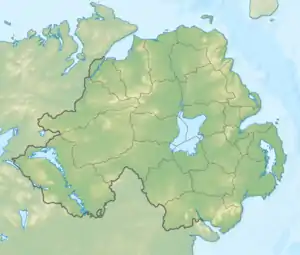Ballygawley land mine attack
In the Ballygawley land mine attack of 13 July 1983, four soldiers of the British Army's Ulster Defence Regiment (UDR) were killed by a Provisional Irish Republican Army (IRA) land mine near Ballygawley in County Tyrone, Northern Ireland. The soldiers were travelling in a convoy of armoured vehicles when the land mine was detonated remotely.
| Ballygawley land mine attack | |
|---|---|
| Part of the Troubles and Operation Banner | |
_-_geograph.org.uk_-_144160.jpg.webp) The approximate site of the attack (2006) | |
 | |
| Location | Near Ballygawley, County Tyrone, Northern Ireland |
| Coordinates | 54°31′42″N 7°12′39″W |
| Date | 13 July 1983 |
| Target | Ulster Defence Regiment personnel |
Attack type | Improvised land mine |
| Deaths | 4 soldiers |
| Perpetrator | Provisional IRA |
Background
Since 1970, the IRA had been waging a guerrilla campaign against the British security forces in Northern Ireland. The IRA's East Tyrone Brigade was particularly active. The Irish Times reported: "This stretch of road has been a favourite ambush spot for successive generations of IRA men since the 1920s. [...] In March 1973 a British Army lieutenant was killed when his armoured car was blown up by a similar 500 lb landmine along the same road".[1] In February 1983 the IRA shot dead an off-duty UDR soldier in Ballygawley.[2]
Attack
On the morning of 13 July 1983, soldiers of the 6th Battalion UDR were travelling in a convoy of five armoured Land Rovers from St Lucia Barracks, Omagh to Ballykinler Barracks for a training exercise.[1] As the convoy was about to begin the long descent down Ballymacilroy Hill into Ballygawley, a 600-pound (270 kg) land mine exploded under the last vehicle.[1] It had been planted in a culvert underneath the road and detonated remotely.[1] The blast threw the vehicle into the air and gouged a large crater in the road.[1] Three soldiers were killed outright and a fourth died later in hospital. The soldiers killed were Ronald Alexander (19), Thomas Harron (25), John Roxborough (19), and Oswell Neely (20), all Protestants from Northern Ireland.[2][1]
Two men received life sentences for the attack and for the killing of RUC officer Paul Clarke in Carrickmore four months later.[1] In 1988, the IRA killed eight British soldiers in a bomb attack along the same road, in the Ballygawley bus bombing.[1]
See also
References
- McKittrick, David (2001). Lost Lives: The Stories of the Men, Women and Children who Died as a Result of the Northern Ireland Troubles. Random House. p. 946.
- "Sutton Index of Deaths from the Conflict in Ireland: 1983". Conflict Archive on the Internet.